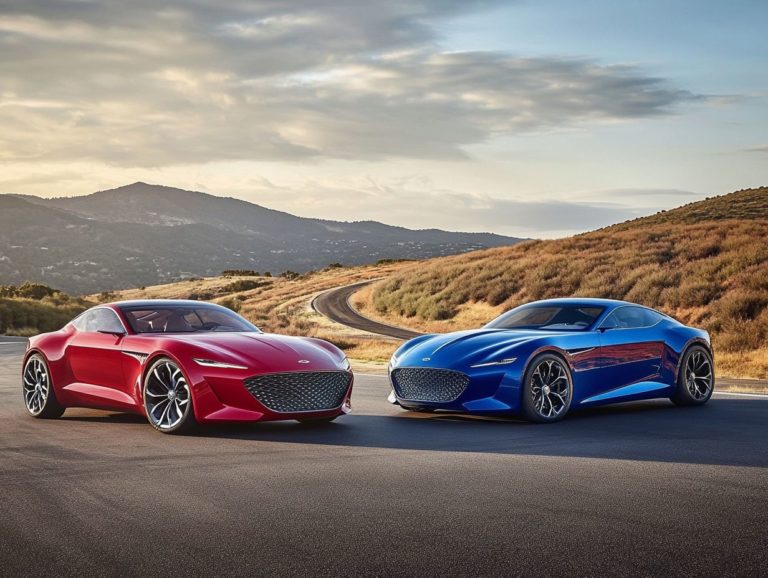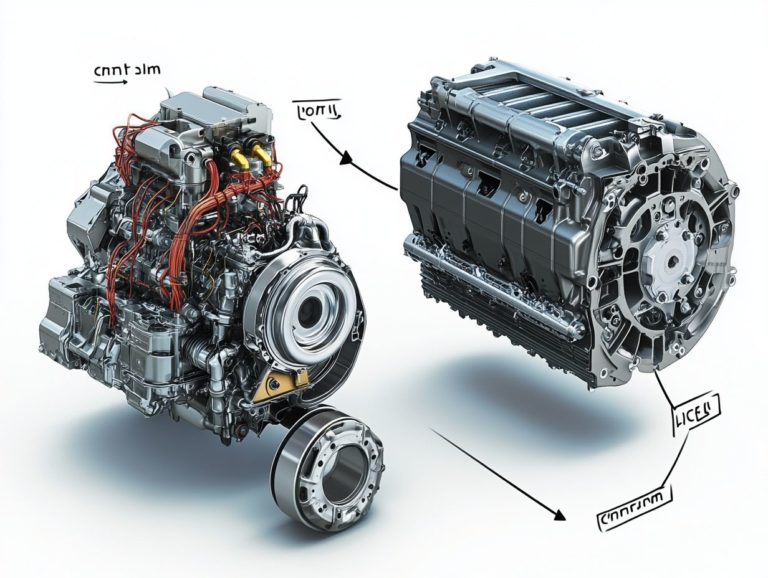Comparing Fuel Tank Capacity Across Models
Understanding fuel tank capacity is crucial for anyone aiming to make informed decisions about their vehicle!
This article explores various factors that influence fuel tank capacity, such as vehicle size, engine type, and efficiency. Understanding fuel tank capacity is important, particularly regarding driving range and costs, along with a comparison of capacities across popular models.
As you consider your personal driving needs, weighing efficiency trade-offs when selecting the right vehicle is essential.
Let s dive into how to make the best choice for your driving needs!
Contents
- Key Takeaways:
- What is Fuel Tank Capacity?
- Factors that Affect Fuel Tank Capacity
- Importance of Fuel Tank Capacity
- Comparison of Fuel Tank Capacity Across Models
- Factors to Consider When Choosing a Model Based on Fuel Tank Capacity
- Frequently Asked Questions
- What is the importance of comparing fuel tank capacity across models?
- How do I determine the fuel tank capacity of a specific vehicle model?
- What factors should I consider when comparing fuel tank capacity across models?
- Is a larger fuel tank always better?
- Are there any other benefits to comparing fuel tank capacity across models?
- Is fuel tank capacity the only factor that affects a vehicle’s range?
Key Takeaways:

- Fuel tank capacity can greatly impact a vehicle’s driving range and cost, making it an important factor to consider when purchasing a car.
- The size and type of a vehicle, along with its engine type and efficiency, can affect its fuel tank capacity and overall performance.
- When comparing fuel tank capacities across models, it’s also important to consider personal driving needs and habits, along with cost and efficiency trade-offs.
What is Fuel Tank Capacity?
Fuel tank capacity is the maximum amount of fuel your vehicle’s gas tank can hold. It plays a crucial role in determining your vehicle’s fuel consumption rates, driving range, and overall fuel economy.
Grasping the nuances of fuel tank options is essential for all vehicle types whether you’re driving a mid-sized sedan, a compact car, an SUV, or a diesel vehicle. This directly impacts performance and costs associated with long journeys, especially in today’s world of fluctuating fuel prices.
Factors that Affect Fuel Tank Capacity
Fuel tank capacity is influenced by several factors, such as the size and type of vehicle, engine efficiency, and the unique ways to manage fuel use utilized by different car models.
For example, mid-sized sedans typically have smaller tanks than their full-sized counterparts or larger trucks, which directly affects both driving range and fuel consumption rates.
Vehicle Size and Type
Vehicle size and type significantly influence fuel tank capacity. Compact cars usually have smaller gas tanks compared to larger models like SUVs and pickup trucks. Trucks like the Chevy Silverado and Ram 1500 are designed for long journeys and have substantial fuel capacities!
Conversely, smaller models such as the Hyundai i10 or Honda Fit are crafted for urban driving and efficiency, typically featuring tanks that hold around 11 to 13 gallons. This design prioritizes fuel efficiency, enabling these vehicles to cover greater distances on less fuel.
In contrast, larger trucks and SUVs not only feature larger tanks, usually ranging from 25 to 30 gallons, but they also consume more fuel due to their heft and power, impacting their overall mileage. These differences in fuel tank sizes illustrate the varying consumption patterns and intended purposes of each vehicle type.
Engine Type and Efficiency

The type of engine you choose plays a crucial role in your vehicle’s fuel efficiency and, as a result, its fuel tank capacity. For instance, diesel vehicles often achieve higher average MPG (miles per gallon), a measure of fuel efficiency, which directly affects the fuel tank size required for commercial trucks compared to their gasoline counterparts.
This distinction becomes clear when examining popular models like the GMC Sierra. The Sierra s diesel engines deliver impressive towing capabilities while maximizing your range. On the other hand, the gasoline variants, though efficient, typically require more frequent refueling for the same distance traveled. The Land Rover Discovery further highlights this balance; its diesel options are perfect for adventurers seeking extended mileage, while the gasoline version offers spirited performance, albeit with trade-offs in fuel economy.
Understanding these differences equips you to choose the right vehicle that meets your specific driving needs!
Importance of Fuel Tank Capacity
Understanding fuel tank capacity is vital for optimizing your driving range, managing fuel expenses, and achieving peak fuel economy. A larger fuel tank can significantly enhance your driving distances between refueling, especially on long journeys.
Fuel tank capacity is essential for managing fuel across all types of vehicles, from compact cars to sizable trucks.
Impact on Driving Range and Cost
Fuel tank capacity plays a crucial role in determining your vehicle’s driving range and the overall expenses tied to fuel consumption. A larger gas tank grants you the freedom to travel longer distances without the anxiety of running out of gas, which becomes essential as fuel prices fluctuate unpredictably.
Imagine the freedom of traveling longer distances on a family road trip. With a vehicle featuring a generous fuel tank, you can minimize dreaded refueling moments especially when prices at the pump seem to rise for no reason. This benefit is a game-changer, especially in remote areas where fuel costs can soar due to a lack of competition.
On the flip side, smaller tanked vehicles may compel you to stop for fuel more frequently, potentially at less favorable rates. By understanding how tank capacity aligns with your driving habits, you can create effective fuel management strategies tailored to your lifestyle whether you re opting for a compact car for urban driving or a robust truck for long hauls.
Comparison of Fuel Tank Capacity Across Models
A comparison of fuel tank capacities across various car models offers valuable insights into fuel efficiency and consumption. By utilizing a fuel tank chart, you can easily observe how vehicles such as the Ford Super Duty, Chevy Silverado, and Toyota Tundra differ in their fuel tank options.
This comparison helps you see which vehicles fit your needs, enabling you to make informed choices based on your requirements.
Top Models and Their Capacities

Top models like the Ford Super Duty, Chevy Silverado, and Toyota Tundra showcase a range of fuel tank capacities, each reflecting their unique design goals and intended uses. Take the Ford Super Duty, for example; it’s engineered for heavy-duty tasks, which means it requires a larger tank to handle its fuel consumption rates.
Then there s the GMC Sierra and Ram 1500, both crafted with specific fuel strategies aimed at blending utility with efficiency. The GMC Sierra, known for its premium features, strikes a balance between power and technology to optimize fuel efficiency. On the other hand, the Ram 1500 has a shape that helps it move through the air easily to boost performance without sacrificing fuel capacity.
Each model s fuel tank capacity isn t just a number; it shows what the engine needs and reflects the manufacturer s commitment to ensuring you can handle long journeys or demanding workloads without a hitch. Understanding these nuances allows you to make informed choices that align perfectly with your needs.
Factors to Consider When Choosing a Model Based on Fuel Tank Capacity
When choosing a vehicle, consider factors such as your personal driving needs, habits, and the desired balance between fuel capacity and efficiency.
Reflecting on your typical driving scenarios whether you frequently embark on long trips or primarily navigate the city will provide valuable insight in selecting the right model with sufficient fuel tank capacity.
This thoughtful approach ensures that your choice aligns seamlessly with your lifestyle and preferences.
Personal Driving Needs and Habits
Understanding your personal driving needs and habits is crucial when selecting a vehicle based on fuel tank capacity.
If you often find yourself setting off on long journeys, choosing a vehicle with a larger gas tank can significantly enhance your convenience. It also lowers the chances of running out of fuel while on the road.
For example, SUVs and trucks typically come with larger fuel tanks. This makes them perfect companions for long-distance travels or off-road escapades, especially in areas where gas stations are scarce. Compact cars, designed for urban driving, usually sport smaller tanks that are more than adequate for shorter trips where refueling is just around the corner.
Incorporating a fuel management system can further elevate your fuel efficiency. It allows you to monitor your consumption patterns more effectively. Such systems analyze your driving behavior, enabling you to tweak your habits for better mileage. They also help tailor your vehicle choice to perfectly align with your lifestyle.
Cost and Efficiency Trade-offs
When evaluating your vehicle options, weigh the costs linked to fuel tank capacity.
Larger tanks may promise extended driving ranges, but they often come with higher initial costs and increased fuel consumption, especially as fuel prices fluctuate.
For many consumers, finding a balance between a vehicle’s purchase price and long-term running costs is paramount. Take a large SUV with a generous fuel tank, for example it may be perfect for family vacations, but expenses can escalate quickly, particularly if it requires premium fuel.
Compact cars shine in fuel efficiency with their smaller tanks. This significantly reduces your expenses at the pump. Hybrids and electric vehicles present additional savings, showcasing a variety of options since their fuel consumption can vary greatly.
Each vehicle type has its own perks and downsides let’s find the right one for you! Assess your individual needs and driving habits carefully.
Frequently Asked Questions

What is the importance of comparing fuel tank capacity across models?
Comparing fuel tank capacity across models allows consumers to make informed decisions about which vehicle will best meet their fuel needs. It also helps determine which vehicle will provide better fuel efficiency and potentially save money on gas expenses.
How do I determine the fuel tank capacity of a specific vehicle model?
The fuel tank capacity of a specific vehicle model can typically be found in the owner’s manual or by doing a quick internet search. You can also visit the manufacturer’s website for more detailed information.
What factors should I consider when comparing fuel tank capacity across models?
Apart from the actual fuel tank capacity, consider the vehicle’s fuel efficiency, driving habits, and intended use. A smaller fuel tank may not be a disadvantage if the vehicle has better fuel efficiency and you frequently stop for gas during long trips.
Is a larger fuel tank always better?
Not necessarily. A larger fuel tank may provide a longer driving range, but it also means more weight for the vehicle to carry, potentially reducing its overall fuel efficiency. Consider the vehicle’s overall design and features when comparing fuel tank capacity.
Are there any other benefits to comparing fuel tank capacity across models?
Absolutely! Comparing fuel tank capacity helps spot discrepancies and makes it easier to choose between similar models.
Is fuel tank capacity the only factor that affects a vehicle’s range?
No, other factors like engine efficiency, driving conditions, and payload can also impact a vehicle’s range. It s essential to consider all of these factors when making a decision based on fuel tank capacity alone.






